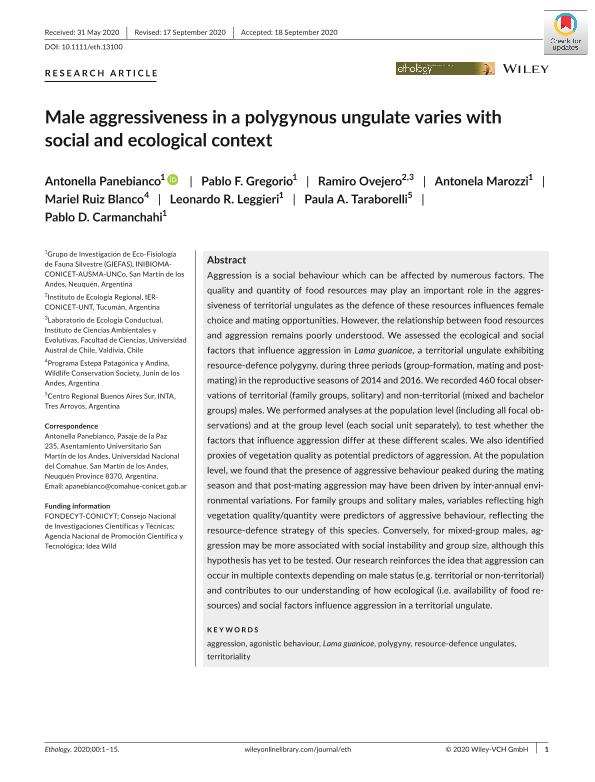Mostrar el registro sencillo del ítem
dc.contributor.author
Panebianco, Antonella

dc.contributor.author
Gregorio, Pablo Francisco

dc.contributor.author
Ovejero Aguilar, Ramiro Jose Antonio

dc.contributor.author
Marozzi, Antonela Alejandra

dc.contributor.author
Ruiz Blanco, Cynthia Mariel

dc.contributor.author
Leggieri, Leonardo Ramón

dc.contributor.author
Taraborelli, Paula Andrea

dc.contributor.author
Carmanchahi, Pablo Daniel

dc.date.available
2021-11-17T21:02:13Z
dc.date.issued
2020-10
dc.identifier.citation
Panebianco, Antonella; Gregorio, Pablo Francisco; Ovejero Aguilar, Ramiro Jose Antonio; Marozzi, Antonela Alejandra; Ruiz Blanco, Cynthia Mariel; et al.; Male aggressiveness in a polygynous ungulate varies with social and ecological context; Wiley Blackwell Publishing, Inc; Ethology; 127; 1; 10-2020; 68-82
dc.identifier.issn
0179-1613
dc.identifier.uri
http://hdl.handle.net/11336/147107
dc.description.abstract
Aggression is a social behaviour which can be affected by numerous factors. The quality and quantity of food resources may play an important role in the aggressiveness of territorial ungulates as the defence of these resources influences female choice and mating opportunities. However, the relationship between food resources and aggression remains poorly understood. We assessed the ecological and social factors that influence aggression in Lama guanicoe, a territorial ungulate exhibiting resource-defence polygyny, during three periods (group-formation, mating and postmating) in the reproductive seasons of 2014 and 2016. We recorded 460 focal observations of territorial (family groups, solitary) and non-territorial (mixed and bachelor groups) males. We performed analyses at the population level (including all focal observations) and at the group level (each social unit separately), to test whether the factors that influence aggression differ at these different scales. We also identified proxies of vegetation quality as potential predictors of aggression. At the population level, we found that the presence of aggressive behaviour peaked during the mating season and that post-mating aggression may have been driven by inter-annual environmental variations. For family groups and solitary males, variables reflecting high vegetation quality/quantity were predictors of aggressive behaviour, reflecting the resource-defence strategy of this species. Conversely, for mixed-group males, aggression may be more associated with social instability and group size, although this hypothesis has yet to be tested. Our research reinforces the idea that aggression can occur in multiple contexts depending on male status (e.g. territorial or non-territorial) and contributes to our understanding of how ecological (i.e. availability of food resources) and social factors influence aggression in a territorial ungulate.
dc.format
application/pdf
dc.language.iso
eng
dc.publisher
Wiley Blackwell Publishing, Inc

dc.rights
info:eu-repo/semantics/openAccess
dc.rights.uri
https://creativecommons.org/licenses/by-nc-sa/2.5/ar/
dc.subject
AGGRESSION
dc.subject
AGONISTIC BEHAVIOUR
dc.subject
LAMA GUANICOE
dc.subject
POLYGYNY
dc.subject
RESOURCE-DEFENCE UNGULATES
dc.subject
TERRITORIALITY
dc.subject.classification
Ecología

dc.subject.classification
Ciencias Biológicas

dc.subject.classification
CIENCIAS NATURALES Y EXACTAS

dc.title
Male aggressiveness in a polygynous ungulate varies with social and ecological context
dc.type
info:eu-repo/semantics/article
dc.type
info:ar-repo/semantics/artículo
dc.type
info:eu-repo/semantics/publishedVersion
dc.date.updated
2021-09-07T14:29:40Z
dc.journal.volume
127
dc.journal.number
1
dc.journal.pagination
68-82
dc.journal.pais
Reino Unido

dc.journal.ciudad
Londres
dc.description.fil
Fil: Panebianco, Antonella. Consejo Nacional de Investigaciones Científicas y Técnicas. Centro Científico Tecnológico Conicet - Patagonia Norte. Instituto de Investigaciones en Biodiversidad y Medioambiente. Universidad Nacional del Comahue. Centro Regional Universidad Bariloche. Instituto de Investigaciones en Biodiversidad y Medioambiente; Argentina
dc.description.fil
Fil: Gregorio, Pablo Francisco. Consejo Nacional de Investigaciones Científicas y Técnicas. Centro Científico Tecnológico Conicet - Patagonia Norte. Instituto de Investigaciones en Biodiversidad y Medioambiente. Universidad Nacional del Comahue. Centro Regional Universidad Bariloche. Instituto de Investigaciones en Biodiversidad y Medioambiente; Argentina
dc.description.fil
Fil: Ovejero Aguilar, Ramiro Jose Antonio. Universidad Nacional de Tucumán. Instituto de Ecología Regional. Consejo Nacional de Investigaciones Científicas y Técnicas. Centro Científico Tecnológico Conicet - Tucumán. Instituto de Ecología Regional; Argentina. Universidad Austral de Chile; Chile
dc.description.fil
Fil: Marozzi, Antonela Alejandra. Consejo Nacional de Investigaciones Científicas y Técnicas. Centro Científico Tecnológico Conicet - Patagonia Norte. Instituto de Investigaciones en Biodiversidad y Medioambiente. Universidad Nacional del Comahue. Centro Regional Universidad Bariloche. Instituto de Investigaciones en Biodiversidad y Medioambiente; Argentina
dc.description.fil
Fil: Ruiz Blanco, Cynthia Mariel. Consejo Nacional de Investigaciones Científicas y Técnicas. Centro Científico Tecnológico Conicet - Patagonia Norte. Instituto de Investigaciones en Biodiversidad y Medioambiente. Universidad Nacional del Comahue. Centro Regional Universidad Bariloche. Instituto de Investigaciones en Biodiversidad y Medioambiente; Argentina
dc.description.fil
Fil: Leggieri, Leonardo Ramón. Consejo Nacional de Investigaciones Científicas y Técnicas. Centro Científico Tecnológico Conicet - Patagonia Norte. Instituto de Investigaciones en Biodiversidad y Medioambiente. Universidad Nacional del Comahue. Centro Regional Universidad Bariloche. Instituto de Investigaciones en Biodiversidad y Medioambiente; Argentina
dc.description.fil
Fil: Taraborelli, Paula Andrea. Consejo Nacional de Investigaciones Científicas y Técnicas. Centro Científico Tecnológico Conicet - Patagonia Norte. Instituto de Investigaciones en Biodiversidad y Medioambiente. Universidad Nacional del Comahue. Centro Regional Universidad Bariloche. Instituto de Investigaciones en Biodiversidad y Medioambiente; Argentina
dc.description.fil
Fil: Carmanchahi, Pablo Daniel. Consejo Nacional de Investigaciones Científicas y Técnicas. Centro Científico Tecnológico Conicet - Patagonia Norte. Instituto de Investigaciones en Biodiversidad y Medioambiente. Universidad Nacional del Comahue. Centro Regional Universidad Bariloche. Instituto de Investigaciones en Biodiversidad y Medioambiente; Argentina
dc.journal.title
Ethology

dc.relation.alternativeid
info:eu-repo/semantics/altIdentifier/url/https://onlinelibrary.wiley.com/doi/10.1111/eth.13100
dc.relation.alternativeid
info:eu-repo/semantics/altIdentifier/doi/http://dx.doi.org/10.1111/eth.13100
Archivos asociados
